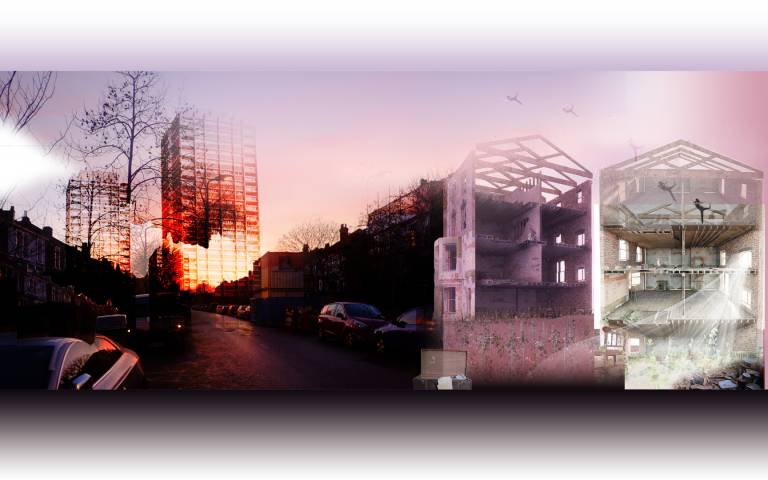Research
 Subject
Subject

Beyond Urban Tragedy: Exploring Race, Gender and the City. Using storytelling in film and performance to illuminate experiences of spaces of Oppression and Liberation in Architecture.
First and second supervisors
Abstract
In 1969 Jean Rhys wrote Wide Sargasso Sea, a backstory to ‘the madwoman in the attic’, Bertha, from Charlotte Bronte’s Jane Eyre. Renaming her Antoinette, Rhys’s post-colonial critique explores themes of power, gender, race and not belonging. It looks at Caribbean history, double consciousness (W.E.B Du Bois, 1903), madness and architecture. We see architecture used as a tool to confine a Creole woman, her mind and arguably also the traces of Black, African influenced culture, which she grew up surrounded by. Similar themes of patriarchy verses women, and the use of space as a means of control are found in Euripides’s Antigone. What these women both share is an idea of badness and transgression.
This research explores the interaction of these characters' inner worlds with the external material of architecture, taking a transdisciplinary approach, which uses storytelling film, performance, writing and virtual representation, as tools to communicate their experience. It responds to the contemporary, post pandemic, George Floyd and #metoo era, in which race and gender and their relationship to architecture have been re-examined.
The thesis argues that architecture is still unwittingly complicit in many real tragedies which unfold in our cities. That in the contemporary urban landscape we see echoes of
classical tragedy. Cities in which people of colour have well-documented, poorer mental outcomes, partly due to living in the urban environment, where incidences of severe mental illness are higher (Golembiewski, 2017). Cities where architecture is also has been disproportionately used to confine women and people of colour (Appignanesi, 2010). Cities in which now and then protests erupt. Therefore, this research will ask how architecture might disrupt these built environment narratives, what it coins ‘Urban Tragedy’ through processes that build moments of liberation.
Referring to both real world figures such as the 1930s Architect, Amaza Lee Meredith Virginia home ‘of her own’ and fictional characters' worlds, as moments of agency to learn from. But can architecture liberate? Foucault argues architecture has no inherent agency. (Foccualt,1982). This thesis considers whether architecture, and by extension architects, are indeed so innocent.
The research takes the form of a series of films and performances. Taking Hackney as a context, we travel through memories and imagination to explore African migrant pasts and speculate on alternative, architectural futures.
Biography
Sarah Akigbogun is MPhil/PhD student in Architectural Design at The Bartlett School of Architecture. Her research takes an allegorical approach to exploring the experiences of the built environment with respect to race and gender.
Sarah is a transdisciplinary practitioner; an Architect, filmmaker, and actor. She holds a degree in Architectural Engineering from the University of Westminster, a Diploma in Architecture from the Architectural Association and a Masters in Acting from Drama Centre London, Central St Martins.
Prior to her PhD, Sarah spent several years in working in practices such as Alsop Architets and Foster and Partners, before founding her own studio. She has since evolved her practice, which utilises performance and film as tools for research, design and advocacy. Sarah is founder of Studio Aki, a Wallpaper Emerging practice of 2021, of Appropri8 theatre, and the XXAOC (Female Architects of Colour Project) project. She is a former Vice Chair of Women in Architecture.
Sarah has taught design at The University of Canterbury, on the Bartlett’s Architecture MSci, a Professional Studies tutor at the AA and on the Media Studies programme at the Royal College of Art, where she leads MS15 ‘Homescapes’.
Publications
- Akigbogun , S. (2021) ‘Zoe Zenghelis - Building a House of Her Own’, in H. Khosravi and T. Issaias (eds.) Fields, Fragments, Fictions. Pittsburgh: Carnegie Museum of Art.
- Akigbogun , S. (2021) Out of the archive: Zoe Zenghelis at the AA, The Architects’ Journal. Available at: https://www.architectsjournal.co.uk/practice/culture/exhibition-zoe-zeng... (Accessed: 22 February 2024).
- Akigbogun , S. (2021b) ‘Uncovering Hidden Women In Architecture’’, in K. Donaldson, anning McBride, and M. Prunotto (eds.) Inflection: Journal of the Melbourne School of Design. Melbourne, Victoria: Melbourne Books.
- Akigbogun, S. (2019) In conversation ... Sharon Egretta sutton, Parlour. Edited by J. Clarke and S. Asworth. Available at: https://parlour.org.au/series/in-conversation/in-conversation-with-sharo...
- Akigbogun , S. (2019) Searching for female architects of colour, Parlour. Edited by J. Clarke and S. Asworth. Available at: https://parlour.org.au/intersections/searching-for-female-architects-of-... (Accessed: 22 February 2024).
Links
- Visit Omar Abolnaga's Twitter profile
- Visit Omar Abolnaga's LinkedIn profile
- Visit Omar Abolnaga's Instagram profile
- Read Omar Abolnaga's work on Medium
Image: Sarah Akigbogun
 Close
Close

